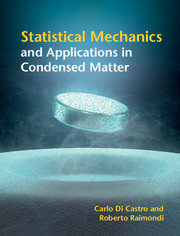Book contents
- Frontmatter
- Contents
- Preface
- 1 Thermodynamics: a brief overview
- 2 Kinetics
- 3 From Boltzmann to Boltzmann–Gibbs
- 4 More ensembles
- 5 The thermodynamic limit and its thermodynamic stability
- 6 Density matrix and quantum statistical mechanics
- 7 The quantum gases
- 8 Mean-field theories and critical phenomena
- 9 Second quantization and the Hartree–Fock approximation
- 10 Linear response and the fluctuation–dissipation theorem in quantum systems: equilibrium and small deviations
- 11 Brownian motion and transport in disordered systems
- 12 Fermi liquids
- 13 The Landau theory of second order phase transitions
- 14 The Landau–Wilson model for critical phenomena
- 15 Superfluidity and superconductivity
- 16 Scaling theory
- 17 The renormalization group approach
- 18 Thermal Green functions
- 19 The microscopic foundations of Fermi liquids
- 20 The Luttinger liquid
- 21 Quantum interference effects in disordered electron systems
- Appendix A The central limit theorem
- Appendix B Some useful properties of the Euler Gamma function
- Appendix C Proof of the second theorem of Yang and Lee
- Appendix D The most probable distribution for the quantum gases
- Appendix E Fermi–Dirac and Bose–Einstein integrals
- Appendix F The Fermi gas in a uniform magnetic field: Landau diamagnetism
- Appendix G Ising and gas-lattice models
- Appendix H Sum over discrete Matsubara frequencies
- Appendix I Two-fluid hydrodynamics: a few hints
- Appendix J The Cooper problem in the theory of superconductivity
- Appendix K Superconductive fluctuation phenomena
- Appendix L Diagrammatic aspects of the exact solution of the Tomonaga–Luttinger model
- Appendix M Details on the theory of the disordered Fermi liquid
- Appendix N Answers to problems
- References
- Index
21 - Quantum interference effects in disordered electron systems
Published online by Cambridge University Press: 05 September 2015
- Frontmatter
- Contents
- Preface
- 1 Thermodynamics: a brief overview
- 2 Kinetics
- 3 From Boltzmann to Boltzmann–Gibbs
- 4 More ensembles
- 5 The thermodynamic limit and its thermodynamic stability
- 6 Density matrix and quantum statistical mechanics
- 7 The quantum gases
- 8 Mean-field theories and critical phenomena
- 9 Second quantization and the Hartree–Fock approximation
- 10 Linear response and the fluctuation–dissipation theorem in quantum systems: equilibrium and small deviations
- 11 Brownian motion and transport in disordered systems
- 12 Fermi liquids
- 13 The Landau theory of second order phase transitions
- 14 The Landau–Wilson model for critical phenomena
- 15 Superfluidity and superconductivity
- 16 Scaling theory
- 17 The renormalization group approach
- 18 Thermal Green functions
- 19 The microscopic foundations of Fermi liquids
- 20 The Luttinger liquid
- 21 Quantum interference effects in disordered electron systems
- Appendix A The central limit theorem
- Appendix B Some useful properties of the Euler Gamma function
- Appendix C Proof of the second theorem of Yang and Lee
- Appendix D The most probable distribution for the quantum gases
- Appendix E Fermi–Dirac and Bose–Einstein integrals
- Appendix F The Fermi gas in a uniform magnetic field: Landau diamagnetism
- Appendix G Ising and gas-lattice models
- Appendix H Sum over discrete Matsubara frequencies
- Appendix I Two-fluid hydrodynamics: a few hints
- Appendix J The Cooper problem in the theory of superconductivity
- Appendix K Superconductive fluctuation phenomena
- Appendix L Diagrammatic aspects of the exact solution of the Tomonaga–Luttinger model
- Appendix M Details on the theory of the disordered Fermi liquid
- Appendix N Answers to problems
- References
- Index
Summary
This chapter provides an introduction to the theory of strongly disordered electron systems. As for the case of superconductivity, the understanding of transport and thermodynamical properties of dirty metals and semiconductors required the introduction of new concepts in solid-state physics.
In non-interacting systems the quantum interference effects yield corrections to the Drude–Boltzmann classical theory of electrical transport (developed in Chapter 11) and for sufficiently strong disorder the correction terms produce a transition to an insulating phase where the electrons are localized, named the Anderson localization (Anderson (1958)).
To emphasize the peculiarity of this transition, we recall that in a perfect crystal, according to Bloch theory, the electron states are extended plane waves modulated by the crystalline potential, grouped in finite energy bands. Within this picture, partial occupation of the bands leads to a metallic state, whereas insulators and semiconductors have an energy gap between the last fully occupied band and the first empty one. The classification of metallic and insulating states is done accordingly to the above filling procedure. The new aspect introduced by Anderson is the possibility of an insulating state arising from the localization of the electron wave function in a partially occupied band.
The effect of electron–electron interaction also introduces surprising effects. The resulting scenario is different from the single-particle picture and provides an effective Fermi liquid picture with frequency and momentum dependent Landau parameters. These parameters then become scale dependent and give rise to a complex flow of the renormalization group equations.
There exist several review articles which give an account of the problem from different viewpoints and at different stages of the historical development (Bergmann (1984); Lee and Ramakrishnan (1985); Altshuler and Aronov (1985); Finkelstein (1990); Belitz and Kirkpatrick (1994); Di Castro and Raimondi (2004)).
We will concentrate here on those aspects that we believe are fundamental for the understanding of the problem. Therefore we present, at first, the theory in a simple phenomenological way, then we introduce all the required technicalities necessary to proceed towards a microscopic theory.
- Type
- Chapter
- Information
- Statistical Mechanics and Applications in Condensed Matter , pp. 375 - 421Publisher: Cambridge University PressPrint publication year: 2015



